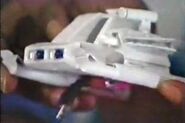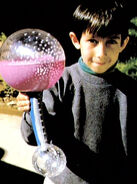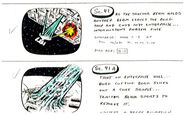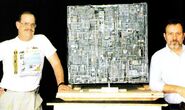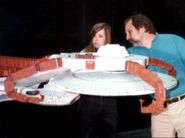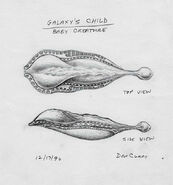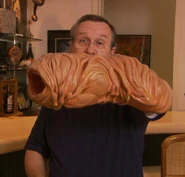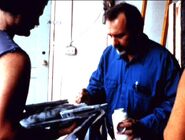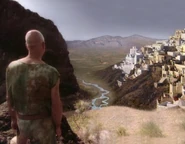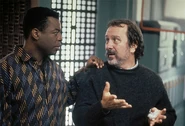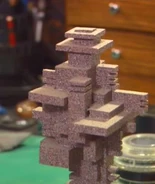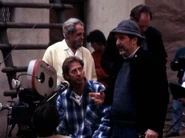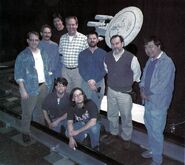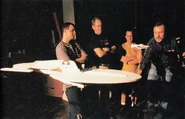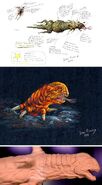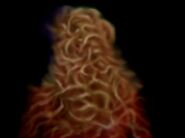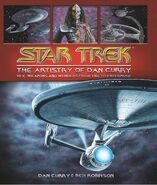
|

|
Dan Curry (born 22 September 1946; age 78) was a senior member of the special and visual effects (VFX) team and served as visual effects supervisor on Star Trek: The Next Generation (from the second half of season one onward), and as visual effects producer on the entire runs of Star Trek: Deep Space Nine, Star Trek: Voyager and Star Trek: Enterprise.
Star Trek
While Dan Curry is usually associated with his VFX work for the modern television franchise, his very first Star Trek credit was actually for the film Star Trek IV: The Voyage Home, for which he designed the titles as graphics artist, his profession by trade. Apart from this film, he later made a small uncredited contribution to Star Trek V: The Final Frontier with his friend Ronald B. Moore, when they supervised the VFX of a single effects scene (Flying Starships, p. 77), and revisited his graphic design origins by designing the titles for Star Trek Generations.
A highly respected professional by his peers, Curry has won seven Emmy Awards for his work on Star Trek, an additional twelve nominations (the majority of them shared with close friend and collaborator Ron Moore), supplemented with two International Monitor Awards and one Visual Effects Society Award with an additional nomination to boot, in the process becoming one of the most honored Star Trek production staffers, only surpassed by Michael Westmore, though Curry has more actual wins. 1999 in particular was a fruitful year for Curry when he was nominated no less than four times for an Emmy, winning one of them. His Star Trek origins as a title designer was reflected in his only non-VFX award nomination, when he was (co-)nominated for a graphics design Emmy for the title design of Voyager in 1995.
Becoming one of the most, if not the most, versatile VFX staffer on the Star Trek television franchise, Curry was honored by SkyBox International with an individual card entry, no. 22, in their 1993 specialty Star Trek: The Next Generation - Behind the Scenes trading card set.
The Next Generation
As VFX supervisor, the first Star Trek staffer to hold the title, Dan Curry was brought in around the turn of 1987-1988 as the final senior VFX staffer, after both the senior VFX staff, consisting at the time of Gary Hutzel, Robert Legato and Ronald B. Moore, and the producers realized that the new Star Trek: The Next Generation show was the most VFX laden television production of its day, much like its illustrious predecessor, Star Trek: The Original Series was in its. A fourth senior VFX staffer was deemed necessary to alleviate work pressure, and Curry was brought in, partly on recommendation by his friend Moore. Actually, Curry had already provided storyboard services for the new series' pilot episode "Encounter at Farpoint" as a freelance graphic artist, albeit uncredited, before getting his tenured position. (Star Trek: The Magazine Volume 2, Issue 12, p. 67) The title "Visual Effects Supervisor" was introduced in the television franchise on that occasion. In order to streamline and increase production efficiency, the four were paired in two teams to work on alternating episodes, Curry being paired with his friend. Joining the Star Trek franchise halfway through the first season, the 16th (12th production number) episode, "Too Short A Season", was the first episode Curry and Moore worked upon as a team, according to Star Trek: The Next Generation Companion, 3rd ed., p. 31, and as was confirmed by himself. (Cinefantastique, Vol 23 #2/3, p. 40) The format worked so well, that it has remained in use for almost the entire subsequent run of the Star Trek television franchise, though the set boundaries in the two-team format became a lot more fluid during the later seasons of Deep Space Nine, Voyager and Enterprise.
Like so many of his production staff colleagues (including Moore), Curry was an Original Series fan, but has always kept it professionally under wraps, due to the studio's non-hiring fans policy. Nevertheless, him being a fan, was exceptionally useful when it came to producing The Next Generation's sixth season homage episode "Relics", as it was Curry who remembered the Original Series footage of the empty bridge, that was eventually used in the scene where Montgomery Scott entered the holodeck. Not only that, but "We used the original Star Trek transporter sparkle [note: aboard the USS Jenolen]. I used to work at Cinema Research [note: one of the Original Series VFX companies], and I remembered that in the bowls of their stock footage storage room was an old box labeled "Star Trek Transporter Sparkle". We blew the cobwebs off, dug through, pulled out the strip of film, and discovered it was in perfect condition.", Curry recalled. (Star Trek: The Next Generation 365, p. 274)
Not only highly respected by his colleagues, Curry, in turn, had the highest regards for them too as was evidenced in a letter he, somewhat irked, wrote to the magazine Cinefantastique, feeling compelled to set the record straight when an article inadvertently downplayed the roles of Moore and Hutzel, referring to them as "assistants", "Ron Moore and Gary Hutzel were referred to as assistants to myself and Rob Legato in your article on STAR TREK effects [12:2/3:39 –typo; meant was, Vol. 23, #2/3, p. 39 –]. This is not the case and being referred to as such diminishes their incredibly valuable contributions to the show. Up until this season Ron and Gary were Visual Effects Coordinators and had a wide range of responsibilities ranging from scheduling and logistics, to direct creative involvement in bringing the effects into existence. Both men also served as Visual Effects Supervisors on several episodes where they had the opportunities to show the technical and creative resources that led to their being offered the position of Visual Effects Supervisors for this current season." (Cinefantastique, Vol 23,#5, p. 62)
Becoming Visual Effects Producer
After Deep Space Nine went into production, an extra management layer was deemed necessary to oversee and coordinate the efforts of the now two-production VFX teams in order to alleviate the workload on Producer Peter Lauritson, who up until then was the managerial overseer of the VFX department, among his many other post-production responsibilities. It was Dan Curry who was promoted into the newly conceived position of "VFX Producer", a position he held for the remainder of the Star Trek television franchise, and, until the advent of Star Trek: Discovery in 2017, the only television Star Trek VFX staffer to ever hold the title. By becoming producer, Curry became for modern televised Star Trek, what Edward K. Milkis had been for the Original Series and incidentally, had been at the very start of The Next Generation before Curry joined. His elevation into this position was all the more remarkable as Curry, unlike most of his colleagues, did not sport a formal background in cinematography or photography, but rather one in the artistic direction, graphics and design. Being a producer though, did not mean that Curry became an office locked manager. Throughout the rest of his Star Trek tenure, Curry remained a highly hands-on VFX staffer, continuing doing the practical work he had done up until then, even if he had to learn to delegate more of the work to his staff of supervisors and coordinators due to his added responsibilities.
In the Star Trek franchise, it was customary from the very beginning, when more than one production was simultaneously in development at any given time (starting with The Final Frontier), to avoid cross-over work being done by staffers assigned to different productions, though there, "(...) was no good reason for this that we could perceive", a slightly chagrined Doug Drexler once noted. [1](X) To this end studio staffers, once assigned to, and contracted for one television production, were formally forbidden to work on any of the others. The legal proviso however, did not extend to outside vendors, such as Image G and CGI companies like Digital Muse and Foundation Imaging, though the original intent was to keep the work of the latter two as separate as possible. Likewise Mike Okuda's Scenic Art Department and Michael Westmore's Make-Up Department were exempt from the proviso for the obvious reason to maintain visual consistency within the franchise, though the exemption only applied to them, and not their staff. For equally obvious reasons, this did not held true for the very highest management echelons either, and Curry's position as VFX producer was counted amongst them. In 1994, for example, Curry worked concurrently on all three television series, The Next Generation, Deep Space Nine and Voyager, while his VFX staff of supervisors and coordinators, whose work he oversaw and coordinated, at first strictly adhered to their assigned productions. As producer, Curry was therefore one of the very few, if not the only one, VFX staffers to have worked on all seasons of the Star Trek spin-off television properties. Practical considerations made the format somewhat untenable for his teams during the later seasons of Deep Space Nine and Voyager, especially for the effects heavy episodes, the season, and series finales in particular, forcing the studio to relax the legal proviso for some teams for them to become cross-over "swing"-teams, as VFX Supervisor David Takemura has once put it. [2](X)
Other Star Trek live-action production functions
Dan Curry was also the second unit director for all of the Star Trek spin-offs. However, he was also given the opportunity to flex his muscles as first unit director, and directed one episode of The Next Generation, the sixth season's "Birthright, Part II".
As a master of Tai chi, Curry choreographed the Klingon fighting technique Mok'bara and has designed the famous Klingon weapon for it, the bat'leth. Apart from the Klingon weaponry, Curry has, besides his regular duties as VFX supervisor, on occasion pitched in as a designer/production illustrator (using his artistic background) and model maker and has designed for example the D'Arsay archive for The Next Generation, as well as the two Kazon starship classes, the Hanonian land eel and the Borg unicomplex for Voyager. For Deep Space Nine's sixth season episode "A Time to Stand", he built the kit-bash studio model USS Curry, which was named for him. His very first contributions as such however, already upon being hired, were the kit-bash build of the shuttle drone and his modification of his matte painting of Relva VII, seen in the Next Generation first season episodes, "11001001" and "Coming of Age", the two episodes directly following his first VFX assignment, hard on the heels followed by his more prominent design and build of the Echo Papa 607 weapons system, seen in "The Arsenal of Freedom", and which on-screen movements he also choreographed in person, already utilizing his Tai chi skills. (Flying Starships, p. 52) In effect, Curry has recalled this episode with fondness, "One of my favorite stories about the show was the way we made the drone robot for the episode titled "Arsenal of Freedom". Its primary components were a shampoo bottle, a plastic Easter egg, and a pantyhose container!" (Star Trek: The Next Generation - Behind the Scenes, card 22)
Already applied in this very first episode he worked upon, Curry gained a reputation for his practical and down-to-earth approach, when it came to creating physical VFX elements, by using whatever mundane object that crossed his path to construct these elements, explaining in a 2012 vidcast interview for Trekland, "Well, I think somebody said, "How low-tech can you go?", but I really didn't care what it was I used; I really cared that a spaceship might be a shampoo bottle with two toy submarines crewed to it, and if it looked right that was what it was. So, I was kind of not really given much thought to what it was originally, as opposed to what it actually looked liked.", further elaborating that the ship was actually built this way for intended use in the second season episode, "Loud As A Whisper", though it was ultimately not featured there. [3] Scenic Artist Mike Okuda was one of the Star Trek staffers, who has expressed his admiration for Curry's improvisation talents, "He delights in finding different solutions to things. Where the proper way to do something might be a very hi-tech solution, he'll say "Oh, why don't we try filming a silver pom-pom?" And he's right, it looks good." (TNG Season 5 DVD-special feature, "Departmental Briefing Year Five: Visual Effects") Pom-poms were used on at least two occasions, such as for the creation of the USS Enterprise-D's force field, lighting up when the Crystalline Entity approaches the ship in "Datalore" (Cinefex, issue 37, p. 9), as well as for the creation of the USS Jenolan's force field when it pried open the airlock doors of the Dyson sphere, allowing the trapped Enterprise-D to escape in "Relics". (Make it So)
In a nineteen-minute interview with Curry on the TNG Season 6 DVD disc 7 entitled "Dan Curry Profile", he talks about how some of his props were conceived and how his experience with martial arts informed much of the Klingon style of battle. The special also revealed that Curry has retained a considerable amount of Star Trek production items as his personal collection, but also that he is a collector of Star Trek merchandise.
Curry has also made in-universe Deep Space Nine appearances as the image of Dekon Elig in the episode "Babel" and Ches'sarro Seeto in the episode "Necessary Evil".
During his tenure on Enterprise CGI became rapidly more advanced, and during the run of the series it became possible to start featuring articulated digital alien life-forms. Ron Moore has credited Curry with designing the motion capture suits, performers wore during life filming, digitally recording the movements they made, to be overlaid in post-production at Eden FX with the digital life-forms of the week. One of Curry's lesser known contributions, it has helped to bring species like the Xindi-Insectoids and the Tholians come to life. (ENT Season 4 DVD-special feature, "Visual Effects Magic"")
Other official Star Trek work
Aside from the various live-action Star Trek productions, Dan Curry has also painted the cover for DC Comics TOS Special 2, released in late 1994, portraying the USS Enterprise-A and the USS Defiant.
While he was working on Enterprise, Curry has also served as the supervising VFX producer for the film portion of the 2004 Borg Invasion 4D-ride at the Las Vegas Star Trek: The Experience-attraction, though remaining uncredited for it. (VOY Season 7 DVD-special feature, "The Making of Borg Invasion 4D")
2020 saw the release of the reference book Star Trek: The Artistry of Dan Curry showcasing Curry's work for the Star Trek franchise. Curry co-authored the book with Ben Robinson. Robinson incidentally, has been the project manager of the British Star Trek: The Official Starships Collection partwork publication, and Curry has on occassion volunteered his input for that publication, particularly for those issues that concerned his own designs. The book subsequently resulted from the contacts Robinson and Curry had with each other on these occassions, as Robinson began to realize that Curry's seminal Star Trek work encompassed far more than could be covered in his partwork publication. Robinson had seven years earlier provided similar services for the autobiography Flying Starships of Curry's long-time friend and VFX colleague Ronald B. Moore, dealing with largely the same subject matter.
Unofficial Star Trek work
Outside the official Star Trek framework, Dan Curry has worked in 2007, as VFX consultant for James Cawley's fan-made internet series Star Trek: New Voyages episode "World Enough and Time", which featured fellow Star Trek alumni George Takei, Grace Lee Whitney, Majel Barrett Roddenberry, John Carrigan, Jeffery Quinn, writer and director Marc Scott Zicree, writer Michael Reaves, Doug Drexler, Iain McCaig, James Van Over, Michael Okuda, Daren Dochterman, Pierre Drolet, Sam Mendoza, Ronald B. Moore, Lee Stringer, Gregory Jein, Philip Kim, Leslie Hoffman, and Tom Morga.
TNG: "Q Who"
TNG: "Realm of Fear"
VOY: "Ex Post Facto"
Co-author, Illustrator
Career outside Star Trek
Hailing from the East Coast, Dan Curry has developed a keen interest in art and film from early childhood on. "Even when playing with toy soldiers, my eye was a camera and I was directing imaginary movies.", Curry recalled. After having seen the classic The Beast from 20,000 Fathoms (1953), he even, still as a young boy, managed to construct a crude optical printer with a broken 8mm projector and some tracing paper. Curry graduated with a degree in Fine Arts at the Middlebury College in Vermont and subsequently with a degree in Fine Arts in Film and Theatre at the Humboldt State University in California, before joining the US Peace Corps in Thailand, doing various art, architecture and film jobs, while learning to speak fluent Thai and Lao, aside from meeting his future wife as well, and became a martial arts expert, among others in Tai chi. Upon his return to the United States, Curry first worked as a Fine Arts teacher at college level giving lessons in painting, drawing, graphic design, set design and fabrication, perspective drawing, and rendering until 1979 when he started to work in the motion picture industry, at first as title designer and matte painting artist, the 1982 film Dead Men Don't Wear Plaid being his first recorded credit as title designer. Credits he accumulated as matte painter before he joined the Star Trek franchise were among others the Buck Rogers in the 25th Century (with Scott Squires and fellow matte painter Syd Dutton) and Battlestar Galactica (with David Stipes and based on concept art by Ralph McQuarrie), [4] as well as the films Caveman (1981), Creepshow (1982) and the 1984 documentary The Jupiter Menace, contracted by David Stipes Productions. (Star Trek: The Magazine Volume 1, Issue 3, p. 19)
In the years 1982-1983 Curry worked as art director for Modern Film Effects working on the titles of the 1983 films Triumphs of a Man Called Horse and Stayin Alive. It was at Modern Film Effects that he met and befriended newcomer and future Star Trek co-worker, Ron B. Moore. (Incidentally, Modern Film Effects, was one of the very few, if not only visual effects house in existence at the time, not being hired to work on Star Trek: The Original Series) During the 1980s he did the title designs for a large number of additional productions, including some blockbusters like The Right Stuff (1983), Top Gun (1986, while employed as vice president, director of creative affairs at the by him mentioned Cinema Research) and Beverly Hills Cop II (1987), eventually leading up to The Voyage Home. Even after he was hired on Star Trek, he continued to do so up to 1999 on productions such as Fatal Attraction (1987), Days of Thunder (1990), Wayne's World (1992, and its sequel in 1993) or Superstar (1999), when production of The Next Generation was in hiatus, until his duties on the franchise required his full attention, due to the proliferation of Star Trek productions, starting with Deep Space Nine.
After his tenure at Star Trek, Curry worked as VFX supervisor on Moonlight (2007-2008), the comedy series Chuck (2008 while employed at Eden FX, co-starring Bonita Friedericy and Tony Todd, and produced and occasionally directed by former Voyager cast member Robert Duncan McNeill), with Cult (2013) being his more recent work.
That Dan Curry is highly respected by his peers, is reflected in the fact of his membership of several motion picture organizations like the Directors Guild of America, The American Society of Cinematographers (ASC), The Producers Guild of America, The Visual Effects Society (responsible for the VES Awards), as well as being a founding member of the International CG Society. Aside from this he has served as governor of The Academy of Television Arts and Sciences' Visual Effects Peer Group (responsible for the VFX Emmy awards). [5]
Curry has concurrently lent his talents to "The Overview Institute", an non-profit organization, founded in 2008 and made up of real world space specialists like astronauts, scientists and authors, dedicated to "research and educate both the space community and the general public on the nature and psycho/social impact of directly experiencing space". [6] As consultant he is member of "The Overview Effect" team, the part of the organization, responsible for visualizing the work of the institute by producing documentaries and the like. In the team he has been joined by former Star Trek alumni Douglas Trumbull and John Eaves. [7](X)
Together with his wife Ubolvan and son Devin, Curry operates his own small, Bell Canyon, California based, independent production company Evergreen Productions, LLC, [8] producing predominantly short drama features, among others Eviction (2004), Hired Guns (2011), and the recent The Chronicles of Elijah Sincere (2012).
Star Trek credits
(This list is currently incomplete.)
- Star Trek films
- Star Trek IV: The Voyage Home – Title Designer
- Star Trek V: The Final Frontier – Visual Effects Supervisor (uncredited)
- Star Trek Generations – Title Designer
- TNG: – Storyboard Artist / Visual Effects Supervisor / Visual Effects / Visual Effects Producer
- "Encounter at Farpoint" – Storyboard Artist (uncredited, very first TNG contribution)
- "11001001" – Model Maker (uncredited)
- "Too Short A Season" (Season 1 – Visual Effects Supervisor)
- "Datalore"
- "Angel One"
- "Home Soil"
- "Coming of Age" – also Matte Artist (uncredited)
- "The Arsenal of Freedom"
- "Symbiosis"
- "Conspiracy"
- "Where Silence Has Lease" (Season 2 – Visual Effects Supervisor)
- "The Outrageous Okona"
- "Loud As A Whisper"
- "A Matter Of Honor"
- "The Dauphin"
- "Contagion" – Matte Artist (uncredited)
- "The Royale"
- "The Icarus Factor"
- "Q Who"
- "Up The Long Ladder"
- "The Emissary"
- "Shades of Gray"
- "The Ensigns of Command" (Season 3 – Visual Effects Supervisor)
- "The Survivors"
- "The Bonding"
- "The Enemy"
- "The Vengeance Factor"
- "The Hunted"
- "Deja Q"
- "Yesterday's Enterprise"
- "Sins of The Father"
- "Captain's Holiday"
- "Sarek"
- "Transfigurations"
- "Suddenly Human" (Season 4 – Visual Effects Supervisor)
- "Family"
- "Legacy"
- "Future Imperfect"
- "The Loss"
- "The Wounded"
- "Clues"
- "Galaxy's Child"
- "Identity Crisis" (uncredited)
- "The Nth Degree" (uncredited)
- "Qpid"
- "Half a Life"
- "The Mind's Eye"
- "Redemption"
- "Redemption II" (Season 5 – Visual Effects Supervisor)
- "Ensign Ro"
- "Disaster"
- "Unification II"
- "A Matter Of Time"
- "Hero Worship"
- "The Masterpiece Society"
- "Power Play"
- "The Outcast"
- "The Perfect Mate"
- "I Borg"
- "The Inner Light"
- "Time's Arrow, Part II" (Season 6 – Visual Effects)
- "Realm Of Fear"
- "Man Of The People"
- "Relics"
- "Schisms"
- "True Q"
- "Rascals"
- "A Fistful of Datas"
- "The Quality of Life"
- "Chain Of Command, Part I"
- "Chain Of Command, Part II"
- "Ship In A Bottle"
- "Aquiel"
- "Face Of The Enemy"
- "Tapestry"
- "Birthright, Part I"
- "Birthright, Part II" (also as Director)
- "Starship Mine"
- "Lessons"
- "The Chase"
- "Frame of Mind"
- "Suspicions"
- "Rightful Heir"
- "Second Chances"
- "Timescape"
- "Descent"
- "Descent, Part II" (Season 7 – Visual Effects Producer)
- "Liaisons"
- "Interface"
- "Gambit, Part I"
- "Gambit, Part II"
- "Phantasms"
- "Dark Page"
- "Attached"
- "Force of Nature"
- "Inheritance"
- "Parallels"
- "The Pegasus"
- "Homeward"
- "Sub Rosa"
- "Lower Decks"
- "Thine Own Self"
- "Masks"
- "Eye of the Beholder"
- "Genesis"
- "Journey's End"
- "Firstborn"
- "Bloodlines"
- "Emergence"
- "Preemptive Strike"
- "All Good Things..."
- DS9: – Visual Effects Producer
- "The Homecoming" (Season 2)
- "The Circle"
- "The Siege"
- "Invasive Procedures"
- "Cardassians"
- "Melora"
- "Rules of Acquisition"
- "Necessary Evil"
- "Second Sight"
- "Sanctuary"
- "Rivals"
- "The Alternate"
- "Armageddon Game"
- "Whispers"
- "Paradise"
- "Shadowplay"
- "Playing God"
- "Profit and Loss"
- "Blood Oath"
- "The Wire"
- "Crossover"
- "The Collaborator"
- "Tribunal"
- "The Jem'Hadar"
- "The Search, Part I" (Season 3)
- "The Search, Part II"
- "The House of Quark"
- "Equilibrium"
- "Second Skin"
- "The Abandoned"
- "Civil Defense"
- "Meridian"
- "Defiant"
- "Fascination"
- "Life Support"
- "Destiny"
- "Prophet Motive"
- "Visionary"
- "Distant Voices"
- "Improbable Cause"
- "Through the Looking Glass"
- "The Die is Cast"
- "Explorers"
- "Family Business"
- "Shakaar"
- "Facets"
- "The Adversary"
- "The Way of the Warrior" (Season 4)
- "Hippocratic Oath"
- "The Visitor"
- "The Sword of Kahless"
- "Our Man Bashir"
- "Homefront"
- "Paradise Lost"
- "Crossfire"
- "Return to Grace"
- "Sons of Mogh"
- "Bar Association"
- "Accession"
- "Rules of Engagement"
- "Hard Time"
- "Shattered Mirror"
- "The Muse"
- "For the Cause"
- "The Quickening"
- "To the Death"
- "Body Parts"
- "Broken Link"
- "Apocalypse Rising" (Season 5)
- "The Ship"
- "Looking for par'Mach in All the Wrong Places"
- "Nor the Battle to the Strong"
- "Trials and Tribble-ations"
- "The Assignment"
- "Let He Who Is Without Sin..."
- "Things Past"
- "The Ascent"
- "Rapture"
- "The Darkness and the Light"
- "The Begotten"
- "For the Uniform"
- "In Purgatory's Shadow"
- "By Inferno's Light"
- "Doctor Bashir, I Presume"
- "A Simple Investigation"
- "Business as Usual"
- "Ties of Blood and Water"
- "Ferengi Love Songs"
- "Soldiers of the Empire"
- "Children of Time"
- "Blaze of Glory"
- "Empok Nor"
- "In the Cards"
- "Call to Arms"
- "A Time to Stand" (Season 6)
- "Sons and Daughters"
- "Rocks and Shoals"
- "Behind the Lines"
- "Favor the Bold"
- "Sacrifice of Angels"
- "You Are Cordially Invited"
- "Resurrection"
- "Statistical Probabilities"
- "The Magnificent Ferengi"
- "Waltz"
- "Who Mourns for Morn?"
- "One Little Ship"
- "Far Beyond the Stars"
- "Honor Among Thieves"
- "Change of Heart"
- "Wrongs Darker Than Death or Night"
- "Inquisition"
- "In the Pale Moonlight"
- "His Way"
- "The Reckoning"
- "Valiant"
- "Profit and Lace"
- "Time's Orphan"
- "The Sound of Her Voice"
- "Tears of the Prophets"
- "Image in the Sand" (Season 7)
- "Shadows and Symbols"
- "Afterimage"
- "Take Me Out to the Holosuite"
- "Chrysalis"
- "Treachery, Faith and the Great River"
- "Once More Unto the Breach"
- "The Siege of AR-558"
- "Covenant"
- "It's Only a Paper Moon"
- "Prodigal Daughter"
- "The Emperor's New Cloak"
- "Field of Fire"
- "Chimera"
- "Inter Arma Enim Silent Leges"
- "Badda-Bing, Badda-Bang"
- "Penumbra"
- "'Til Death Do Us Part"
- "Strange Bedfellows"
- "The Changing Face of Evil"
- "When It Rains..."
- "Tacking Into the Wind"
- "Extreme Measures"
- "The Dogs of War"
- VOY: – Visual Effects Producer
- "Caretaker" (Season 1)
- "Parallax"
- "Time and Again"
- "Phage"
- "The Cloud"
- "Eye of the Needle"
- "Ex Post Facto"
- "Emanations"
- "Prime Factors"
- "State of Flux"
- "Heroes and Demons"
- "Cathexis"
- "Jetrel"
- "Learning Curve"
- "Projections"
- "Elogium"
- "Twisted"
- "The 37's"
- "Initiations" (Season 2)
- "Non Sequitur"
- "Parturition"
- "Persistence of Vision"
- "Tattoo"
- "Cold Fire"
- "Maneuvers"
- "Resistance"
- "Prototype"
- "Death Wish"
- "Alliances"
- "Threshold"
- "Meld"
- "Dreadnought"
- "Investigations"
- "Lifesigns"
- "Deadlock"
- "Innocence"
- "The Thaw"
- "Tuvix"
- "Resolutions"
- "Basics, Part I"
- "Sacred Ground" (Season 3)
- "False Profits"
- "Flashback"
- "Basics, Part II"
- "The Chute"
- "Remember"
- "The Swarm"
- "Future's End"
- "Future's End, Part II"
- "Warlord"
- "The Q and the Grey"
- "Macrocosm"
- "Alter Ego"
- "Fair Trade"
- "Blood Fever"
- "Coda"
- "Unity"
- "Darkling"
- "Scorpion"
- "Year of Hell" (Season 4)
- "Concerning Flight"
- "Extreme Risk" (Season 5)
- "In the Flesh"
- "Once Upon a Time"
- "Nothing Human"
- "Timeless"
- "Thirty Days"
- "Infinite Regress"
- "Counterpoint"
- "Gravity"
- "Latent Image"
- "Bride of Chaotica!"
- "The Fight"
- "Bliss"
- "The Disease"
- "Dark Frontier"
- "Course: Oblivion"
- "Think Tank"
- "Juggernaut"
- "Someone to Watch Over Me"
- "11:59"
- "Relativity"
- "Warhead"
- "Equinox"
- "Equinox, Part II" (Season 6)
- "Survival Instinct"
- "Barge of the Dead"
- "Tinker Tenor Doctor Spy"
- "Dragon's Teeth"
- "Alice"
- "Riddles"
- "One Small Step"
- "The Voyager Conspiracy"
- "Pathfinder"
- "Fair Haven"
- "Tsunkatse"
- "Blink of an Eye"
- "Virtuoso"
- "Collective"
- "Memorial"
- "Spirit Folk"
- "Ashes to Ashes"
- "Child's Play"
- "Good Shepherd"
- "Fury"
- "Live Fast and Prosper"
- "Life Line"
- "Muse"
- "The Haunting of Deck Twelve"
- "Unimatrix Zero"
- "Unimatrix Zero, Part II" (Season 7)
- "Imperfection"
- "Drive"
- "Critical Care"
- "Repression"
- "Inside Man"
- "Flesh and Blood"
- "Body and Soul"
- "Nightingale"
- "Shattered"
- "Lineage"
- "Repentance"
- "Prophecy"
- "The Void"
- "Workforce"
- "Workforce, Part II"
- "Human Error"
- "Q2"
- "Author, Author"
- "Friendship One"
- "Natural Law"
- "Homestead"
- "Renaissance Man"
- "Endgame"
- ENT: – Visual Effects Producer
- "Broken Bow" (Season 1)
- "Shuttlepod One"
- "The Crossing" (Season 2)
- "The Expanse"
- "The Council" (Season 3)
- "Countdown"
- Borg Invasion 4D – Visual Effects Producer (uncredited)
Star Trek interviews
- Star Trek DVD and Blu-ray special features:
- on The Next Generation
- TNG Season 1 DVD-special feature, "The Making of a Legend: Visual Effects"
- TNG Season 1 DVD-special feature, "Memorable Missions"
- TNG Season 2 DVD-special feature, "Departmental Briefing Year Two: Production", interviewed on 5 September 2001
- TNG Season 2 DVD-special feature, "Departmental Briefing Year Two: Memorable Missions" ("Loud As A Whisper", "The Dauphin"), interviewed on 5 September 2001
- TNG Season 3 DVD-special feature, "Mission Overview Year Three: Special Guests on the Bridge"), interviewed on 5 September 2001
- TNG Season 3 DVD-special feature "Departmental Briefing Year Three: Art Design and Visual Effects – Visual Effects" ("Deja Q", "Captain's Holiday"), interviewed on 5 September 2001
- TNG Season 4 DVD-special feature, "Select Historical Data" ("Galaxy's Child"), interviewed on 5 September 2001
- TNG Season 5 DVD-special feature, "Departmental Briefing Year Five: Visual Effects"), interviewed on 5 September 2001
- TNG Season 5 DVD-special feature, "Memorable Missions Year Five" ("Hero Worship", "Disaster"), interviewed on 5 September 2001
- TNG Season 6 DVD-special feature, "Bold New Directions Year Six" ("A First Chance at "Second Chances""), interviewed on 5 September 2001
- TNG Season 6 DVD-special feature, "Departmental Briefing Year Six: Production – Profile: Dan Curry", interviewed 7 September 1994 and 17 June 2002
- TNG Season 7 DVD-special feature, "Starfleet Moments & Memories Year Seven" ("A Unique Family"), interviewed on 7 September 1994
- TNG Season 7 DVD-special feature, "The Making of "All Good Things..." Year Seven" ("Visual Effects"), interviewed on 28 April 1994 and 7 September 1994
- TNG Complete Series Boxset-special feature, "Star Trek Visual Effects Magic: A Roundtable Discussion" (2007)
- TNG Season 1 Blu-ray-special feature, "Stardate Revisited: The Origin of Star Trek: TNG" (2012)
- TNG Season 2 Blu-ray-special feature, "Making It So: Continuing Star Trek: TNG" (2012)
- Redemption (Blu-ray)-special feature, "Survive and Succeed: An Empire at War" (2013)
- TNG Season 4 Blu-ray-special feature, "In Conversation: The Star Trek Art Department" (2013)
- TNG Season 4 Blu-ray-special feature, "Relativity: The Family Saga of Star Trek TNG" (2013)
- on Deep Space Nine
- DS9 Season 2 DVD-special feature, "New Station, New Ships", interviewed on 15 April 1999
- DS9 Season 7 DVD-special feature, "Ending An Era", interviewed on 15 April 1999
- on Voyager
- VOY Season 1 DVD special feature, Red Alert: Visual Effects Season One, interviewed on 16 November 1994, 12 December 1994, and 30 July 2003
- VOY Season 2 DVD-special feature, "Red Alert: Visual Effects Season Two", interviewed on 30 July 2003 and on 16 October 2003
- VOY Season 3 DVD-special features, "Flashback to "Flashback"" and "Red Alert: Amazing Visual Effects", interviewed on 14 January 2004 and on 16 October 2003
- VOY Season 4 DVD-special features, "The Birth of Species 8472", "The Art of Alien Worlds" and "Red Alert: Amazing Visual Effects", interviewed on 28 April 2004 and on 16 October 2003
- VOY Season 6 DVD-special features, "Braving the Unknown, Season Six" and "Red Alert: Amazing Visual Effects, interviewed on 28 April 2004 and on 15 July 2004
- VOY Season 7 DVD-special feature, "Coming Home: The Final Episode", interviewed on 15 July 2004
- on Enterprise
- ENT Season 1 DVD-special feature, "NX-01 File 02"
- ENT Season 4 DVD-special features, "Inside the "Mirror" Episodes" and "Visual Effects Magic"
- ENT Season 3 Blu-ray-special feature, "In a Time of War: Call to Arms, Front Lines, Final Conflict"
- on The Next Generation
- Print publications:
- "Special Visual Effects", Mitchell Rubinstein, Cinefantastique, Vol 23 #2/3, pp. 39-41
- "Curry's Heroes", Tim Prokop, Cinefantastique, Vol 25 #6/Vol 26 #1, 1994, pp. 92-93, 124
- "Dan Curry: Into the Digital Realm", Larry Nemecek, Star Trek Monthly issue 31, September 1997, pp. 16-21
- "Dan Curry: STAR TREK's VFX Supreme", Larry Nemecek, Star Trek: The Magazine Volume 1, Issue 3, July 1999, pp. 18-19
- "A Designer's Passion", Wendy Butler, Star Trek Magazine issue 120, April/May 2005, pp. 30-31
- Star Trek documentaries:
Bibliography
- Star Trek: The Artistry of Dan Curry, December 2020 – Co-author, Illustrator
Star Trek awards
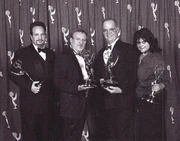
As the second all-time highest honored, but most award winning, Star Trek staffer, Dan Curry received the following award wins and nominations:
- Emmy Award: Dan Curry received the following Emmy Award wins and nominations, all in the category Outstanding Special Visual Effects for a Series, safe for the 1995 nomination for Voyager:
- 1989 Emmy Award nomination for the episode "Q Who", shared with Ronald B. Moore, Peter W. Moyer, and Steve Price
- 1990 Emmy Award nomination for the episode "Deja Q", shared with Ronald B. Moore, Peter W. Moyer, Steve Price, and Don Lee
- 1992 Emmy Award win for the episode "A Matter Of Time", shared with Ronald B. Moore, David Takemura, Erik Nash, Don Lee, Peter Sternlicht, Adam Howard, Syd Dutton, and Robert Stromberg
- 1994 Emmy Award win for TNG: "All Good Things...", shared with David Stipes, Michael Backauskas, Scott Rader, Adam Howard, and Erik Nash
- 1995 Emmy Award nomination in the category Outstanding Individual Achievement in Graphic Design and Title Sequences for Star Trek: Voyager, shared with John Grower, Erik Tiemens, and Eric Guaglione.
- 1995 Emmy Award win for VOY: "Caretaker", shared with Michael Backauskas, Joe Bauer, Edward L. Williams, David Stipes, Joshua Cushner, Don B. Greenberg, Scott Rader, Adam Howard, Don Lee, John Parenteau, Joshua Rose, and Robert Stromberg
- 1999 Emmy Award win for the episode "Dark Frontier", shared with Ronald B. Moore, Mitch Suskin, Elizabeth Castro, Arthur J. Codron, Paul Hill, Don Greenberg, Gregory Rainoff, Rob Bonchune, Adam Lebowitz, and John Teska
- 1999 Emmy Award nomination for "What You Leave Behind", shared with David Lombardi, Kevin P. Bouchez, Adam Howard, Greg Rainoff, Adam Buckner, Arthur J. Codron, Judy Elkins, Robert Bonchune, Steve Fong, Don Greenberg, Paul Hill, Davy T. Nethercutt, Sherry Hitch, Gary Hutzel, David Stipes, Paul Maples, Gary Monak, and Larry Younger
- 1999 Emmy Award nomination for "Timeless", shared with John Allardice, Eric Chauvin, Arthur J. Codron, Robert Bonchune, Don Greenberg, Sherry Hitch, Greg Rainoff, Mitch Suskin, John Teska, and Ron Thornton
- 1999 Emmy Award nomination for the episode "Thirty Days", shared with Ronald B. Moore, Paul Hill, Elizabeth Castro, Gregory Rainoff, and Bruce Branit
- 2000 Emmy Award nomination for the episode "Life Line", shared with Ronald B. Moore, Elizabeth Castro, Bruce Branit, John F. Gross, Fred Pienkos, Jeremy Hunt, Les Bernstien, and Paul Hill
- 2000 Emmy Award nomination for the episode "The Haunting of Deck Twelve", shared with Ronald B. Moore, Elizabeth Castro, Paul Hill, Gregory Rainoff, John F. Gross, Bruce Branit, Fred Pienkos, and Jeremy Hunt
- 2001 Emmy Award win for the episode "Endgame", shared with Ronald B. Moore, Mitch Suskin, Arthur J. Codron, Steve Fong, Eric Chauvin, Rob Bonchune, John Teska, and Gregory Rainoff
- 2001 Emmy Award nomination for the episode "Workforce", shared with Ronald B. Moore, Chad Zimmerman, Paul Hill, Gregory Rainoff, Dave Morton, David Lombardi, John Teska, and Brandon MacDougall
- 2002 Emmy Award win for the episode "Broken Bow", shared with Ronald B. Moore, Arthur J. Codron, Elizabeth Castro, Paul Hill, Steve Fong, Gregory Rainoff, Rob Bonchune, and David R. Morton
- 2003 Emmy Award nomination for the episode "The Crossing", shared with Ronald B. Moore, Armen V. Kevorkian, Paul Hill, David R. Morton, John Teska, Sean M. Scott, and Pierre Drolet
- 2003 Emmy Award nomination for the episode "The Expanse", shared with Ronald B. Moore, Elizabeth Castro, Paul Hill, Fred Pienkos, Gregory Rainoff, Sean M. Scott, Eric Hance, and Bruce Branit
- 2004 Emmy Award win for the episode "Countdown", shared with Ronald B. Moore, Elizabeth Castro, Paul Hill, Gregory Rainoff, Fred Pienkos, Sean M. Scott, David R. Morton, and Chris Zapara
- 2004 Emmy Award nomination for the episode "The Council", shared with Arthur Codron, Koji Kuramura, Pierre Drolet, Steve Fong, Sean Jackson, John Teska, Greg Rainoff, and Mike Stetson
- International Monitor Award
- 1996 International Monitor Award win in the category Film Originated Television Series – Electronic Visual Effects for VOY Season 2, shared with David Stipes, Michael Backauskas, Joe Bauer, Edward L. Williams, Scott Rader, Don Greenberg and Adam Howard
- 1998 International Monitor Award win in the category Film Originated Television Series – Electronic Visual Effects for DS9: "Call to Arms", shared with David Stipes, Adam Buckner, Steve Fong, Kevin Bouchez, Davy Nethercutt, and Don Greenberg
- Visual Effects Society Award: Dan Curry received the following VES Award win and nomination in the categories Best Visual Effects in a Television Series/Outstanding Visual Effects in a Broadcast Series:
- 2003 VES Award nomination for the episode "Shockwave", shared with Ronald B. Moore and Elizabeth Castro.
- 2005 VES Award win for the episode "Storm Front, Part II", shared with Ronald B. Moore, David Takemura, and Fred Pienkos.
External links
- DanCurryGallery.com(X) – archived official site
- Dan Curry at Wikipedia
- Dan Curry at the Internet Movie Database
- Dan Curry profile at Zoominfo.com
- 2006 Dan Curry interview at Seb's Web Archive
- 2007 Dan Curry profile at FXguideTV
- 2012 Dan Curry vidcast interview, Part 1 & Part 2 at Larry Nemecek's Trekland
- 2017 Dan Curry interview at VFXblog.com
